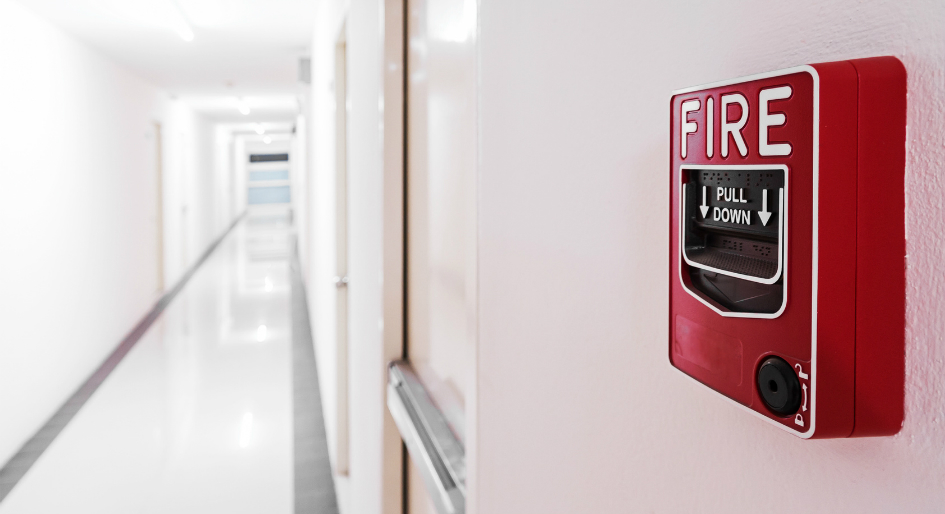Fire prevention begins with detection and assessing possible causes to eliminate potential threats. October marks National Fire Prevention Month, which serves as a reminder to revisit fire safety and prevention practices.
Facilities have a responsibility to protect occupants and assets in the event of a fire, and continued advances in technology are helping to prevent catastrophes in real-time. However, when considering infrastructure updates in comparison to often uncommon fire events, facility managers can tend to push fire safety technology and procedures to the backburner as they focus more on everyday building maintenance concerns.
From establishing emergency plans and protocols to implementing integrated fire and life-safety solutions, there are many ways that facilities can better-position themselves to mitigate the risk of hazards, improve occupant safety and gain maximized efficiencies of building systems.
The Capabilities of Systems Integration
Advanced fire detection and suppression systems allow for the exchange of information in real-time and detection of potential concerns from the baseline. They also provide emergency responders with greater insight during and after fire events. Fire detection and notification technologies can connect to building automation systems, providing centralized control over the entire facility. If a fire erupts in one area, occupants throughout the entire building can be notified early on so that any mandatory evacuation process can be accomplished quicker and easier while avoiding chaos. Detecting fire quickly and understanding the origin of the problem can also result in less damage to building structure and assets.
Mass notification systems are designed to communicate with large groups of occupants that may be impacted by a fire outbreak. These systems can be integrated with other building technologies, allowing for greater situational awareness and quicker response time in the event of an emergency. For example, if a fire erupts in one unit of an apartment complex or multi-residential building, occupancy sensors paired to the mass notification system are able to monitor each individual unit and communicate data on the presence of occupants. This data ensures that each occupied area of the building is reached, and detailed instructions pertaining to evacuation are communicated.
Establishing an emergency preparedness plan and conducting routine tests
Failing to educate and train employees can make a bad situation worse. Employees of all levels should be adequately trained in fire and life-safety protocols and they should be coached to demonstrate a keen awareness around the importance of acting quickly, with regular refreshers. To develop and enforce these plans, fire and life-safety professionals can assist in designing procedures customized to each unique facility, for example, by prescribing evacuation routes. They can also be a valuable resource for routine facility check-ups, including the identification of potential hazards, conducting risk assessments and reviewing the health and performance of systems.
Understanding and alleviating risk factors on-site is essential in avoiding future events. These can include:
- Proper storage of flammable chemicals and equipment
- Pitfalls of outdated appliances and heating systems
- Dangers of electrical hazards, such as overloaded outlets and circuits
Routine inspection, testing and maintenance of building systems can make a big difference in fire prevention. By staying updated on the health of fire safety equipment, safety managers can understand their overall effectiveness and compliance with Fire Codes and referenced Standards. The implementation of smarter technology solutions can help simplify maintenance processes by incorporating predictive maintenance schedules and self-test routines. As a result, testing can be less time-consuming and less disruptive to occupants. For example, smoke detectors can alert staff when they are dirty and need to be cleaned. This simple technology feature helps to prevent nuisance alarms and avoid occupant apathy related to fire alarm activation. New technologies continue to become available to help facilities find easier ways to comply with the Fire Code. Not only are buildings becoming safer, but avoiding the fines associated with non-compliance is a welcome bonus.
Compliance with industry codes and standards
The National Fire Code and Provincial Fire Codes in Canada provide detailed direction outlining the responsibilities of building owners and representatives to ensure continued fire protection system upkeep and testing. Fire Codes often reference other Codes and Standards to further detail specific requirements for various aspects of fire protection systems. For instance, NFPA 10 pertains to portable extinguishers. NFPA25 targets fire sprinkler systems. ULC-S536 describes the testing and maintenance of fire alarm systems. Test scenarios should also be performed to confirm the operation, integration and coordination of individual Life Safety systems as detailed in CAN/ULC-S1001, Integrated Systems Testing of Fire Protection and Life Safety Systems. We are lucky to have so many Codes and Standards which provide exceptional guidance to help us maintain facilities with safety in mind.
National Fire Prevention Month is a great reminder for safety managers to update emergency preparedness plans and protocols to ensure that all codes and standards are followed. Taking the time to properly educate and train employees on fire and life safety plans and protocols can promote greater safety for occupants in the event of an emergency. Periodically testing equipment and ensuring all codes and standards are followed helps to confirm everything has a better chance of performing as expected, especially when it is needed. To simplify these processes and benefit from the advantages of real-time communication and increased safety, advanced technologies and solutions should be considered as part of your facility safety plan. By taking these bold steps forward, facilities can be better prepared to provide protection to all occupants and assets.
Michael Hugh is a senior field sales engineer at Johnson Controls in Mississauga, Ont. During his 30+ years of experience in the fire alarm industry, Michael served as a fire alarm technician, technical support specialist, technical trainer and product manager. He holds an electronic engineering technician diploma from Seneca College and currently serves on the CFAA National Executive Board








